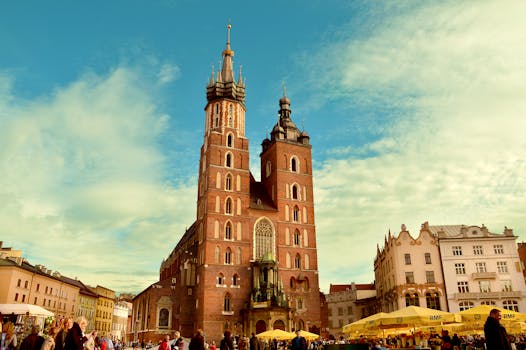Discover the Fascinating Culture of Poland
Poland, a country rich in history and culture, offers a unique blend of tradition and modernity. From the medieval streets of Krakow to the vibrant life of Warsaw, the coastal charm of Gdansk, and the picturesque beauty of Wroclaw, each city tells a story that reflects Poland’s complex past and dynamic present. This article explores the cultural highlights of these four cities, providing insights into their historical significance and contemporary allure.
Krakow: The Heart of Polish Heritage
Krakow, one of Poland’s oldest cities, is often regarded as the cultural capital of the country. Its well-preserved medieval core is a UNESCO World Heritage Site, attracting millions of visitors each year. The city is known for its stunning architecture, vibrant arts scene, and rich history.
Historical Significance
The history of Krakow dates back to the 7th century, and it served as the royal capital of Poland until the late 16th century. Key historical sites include:
- Wawel Castle: A symbol of Polish national identity, this castle was home to Polish kings and is a masterpiece of Renaissance architecture.
- Main Market Square: One of the largest medieval town squares in Europe, it is surrounded by historic buildings, including St. Mary’s Basilica.
- Kazimierz District: Once the center of Jewish life in Krakow, this area is now a vibrant hub of culture, featuring synagogues, museums, and art galleries.
Cultural Experiences
Krakow is also known for its lively cultural scene. Visitors can enjoy:
- Theatrical Performances: The city hosts numerous theaters, including the renowned Juliusz Słowacki Theatre.
- Music Festivals: Events like the Krakow Film Festival and the Jewish Culture Festival celebrate the city’s diverse heritage.
- Culinary Delights: Traditional Polish cuisine can be savored in local restaurants, with dishes like pierogi and oscypek being must-tries.
Warsaw: A City of Resilience
Warsaw, the capital of Poland, is a city that embodies resilience and rebirth. After being almost completely destroyed during World War II, it has been meticulously rebuilt and now stands as a symbol of Polish strength and determination.
Historical Context
The history of Warsaw is marked by significant events, including:
- The Warsaw Uprising: A major World War II operation aimed at liberating the city from Nazi occupation.
- Palace of Culture and Science: A controversial gift from the Soviet Union, this building is now a cultural and educational center.
- Old Town: A UNESCO World Heritage Site, it was reconstructed after the war and features beautiful baroque and gothic architecture.
Modern Cultural Landscape
Today, Warsaw is a vibrant metropolis with a thriving arts scene. Highlights include:
- Museum of the History of Polish Jews: This museum offers a profound insight into the Jewish community’s history in Poland.
- Warsaw Philharmonic: A hub for classical music lovers, hosting performances by world-renowned artists.
- Street Art: The city is adorned with murals and installations that reflect contemporary issues and artistic expression.
Gdansk: The Maritime Gem
Located on the Baltic Sea, Gdansk is known for its rich maritime history and stunning architecture. The city played a pivotal role in the Hanseatic League and has a unique blend of Polish and German influences.
Historical Highlights
Gdansk’s history is marked by:
- The Solidarity Movement: This labor movement, which began in Gdansk, played a crucial role in the fall of communism in Poland.
- Gdansk Shipyard: A historic site where significant events in Polish history unfolded.
- Neptune’s Fountain: A symbol of Gdansk’s maritime heritage, located in the heart of the city.
Cultural Attractions
Visitors to Gdansk can explore:
- The Main Town: Featuring colorful facades and historic buildings, it is perfect for leisurely strolls.
- European Solidarity Centre: A museum dedicated to the history of the Solidarity movement and its impact on Poland.
- Amber Museum: Showcasing the region’s famous amber craftsmanship.
Wroclaw: The City of a Hundred Bridges
Wroclaw, often referred to as the “Venice of Poland,” is known for its picturesque canals and numerous bridges. The city boasts a rich history influenced by various cultures, including Polish, Czech, and German.
Historical Overview
Wroclaw’s history includes:
- The Centennial Hall: A UNESCO World Heritage Site, this architectural marvel is a testament to early 20th-century engineering.
- The Market Square: One of the largest in Europe, it is surrounded by colorful townhouses and the Gothic-style Town Hall.
- Jewish Heritage: The city has a significant Jewish history, with several synagogues and memorials.
Cultural Highlights
Wroclaw offers a vibrant cultural scene, including:
- The Wroclaw Opera: Known for its high-quality performances and stunning venue.
- Wroclaw’s Dwarfs: A quirky attraction, these small bronze statues scattered throughout the city have become a symbol of Wroclaw’s charm.
- Festivals: The city hosts numerous events, such as the Wroclaw Non-Stop Festival and the Wroclaw Jazz Festival.
Conclusion: A Journey Through Poland’s Cultural Tapestry
Exploring Krakow, Warsaw, Gdansk, and Wroclaw offers a profound insight into Poland’s rich cultural heritage and history. Each city presents a unique narrative shaped by its past and present,
